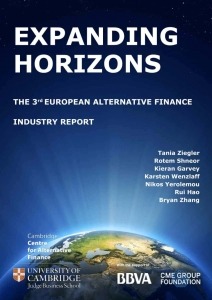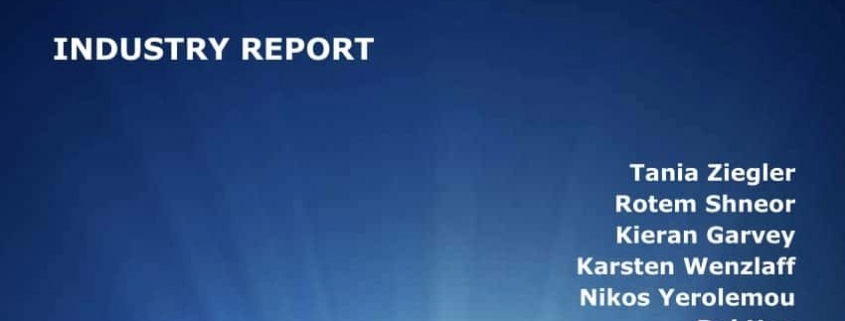Expanding Horizons: The 3rd European Alternative Finance Industry Report
This report presents the findings for the 3rd Annual European Alternative Finance Industry Survey, carried out by the Cambridge Centre for Alternative Finance. The report finds that European online alternative finance (excluding the UK) grew by 101 per cent, reaching €2063m. This report is titled Expanding Horizons to reflect the positive developments in European alternative finance in 2016, and sets a stage for further and future development of the industry. This study was the first to capture market data from 45 European countries, expand inter-European regional analyses, and included four additional models against the previous year. It is also the first to account for issues related to industry innovation, R&D priorities and internationalisation trends.

Highlights from the report
- France, Germany and the Netherlands remain the top three national markets for online alternative finance by market volume in Europe (excluding UK), ). The French market reached €443.98m followed by Germany (€321.84m), the Netherlands (€194.19m), Finland (€142.23m), Spain (€130.90m), Italy (€127.06m) and Georgia (€102.58m), which experienced a boom in 2016. The United Kingdom maintains its position as the main alternative finance market, albeit with a declining market share from 81 per cent in 2015 to 73 per cent in 2016.
- Estonia ranked first for alternative finance volume per capita with €62.68 for a second year in a row, followed by Monaco (€50.78) and Georgia (€27.58). On a per capita basis, France and Germany place twelfth and fourteenth, which contrasts to their positions when analysed in terms of absolute volume generated. Considerable shifts in overall rankings indicate that even countries with smaller online alternative finance volumes may have greater penetration and usage of these models. In almost every instance, high total volume does not necessarily reflect a strong correlation with per capita distribution rankings.
- P2P Consumer Lending accounts for the largest market segment of Alternative Finance in Europe (excluding UK) for a third year in a row. This model accounted for 34 per cent of all volume, and grew by 90 per cent from €366m in 2015 to €697m in 2016. P2P Business Lending (17 per cent of market share), Invoice Trading (12 per cent), Equity-based Crowdfunding (11 per cent) and Reward-based Crowdfunding (9 per cent) rounded out the top-five performing models across the region. .
- Institutionalization grew considerably from 2015 to 2016, with 45 per cent of P2P consumer lending and 29 per cent of P2P business lending funded by institutions such as pension funds, mutual funds, asset management firms and banks. 13 per cent of the investment in equity-based crowdfunding was also funded by institutional investors such as venture capital firms, angels, family offices or funds.
- Online alternative finance for businesses continued to grow, providing €1126m to 14,521 businesses across the region. Debt models (including P2P Business Lending, Invoice Trading, etc.) accounted for 67 per cent of all business finance, while equity models (Equity-based Crowdfunding, etc.) accounted for 27 per cent. France (€218m), the Netherlands (€182m), Spain (€100m), Germany (€97m) and Italy (€88m) drove business-based alternative finance volumes, supporting their SME market through a variety of models.
Prospects
While consolidation exists within certain jurisdictions, new platforms continue to emerge while others disappear. Surviving platform operators continue to innovate and expand, bringing new products and channels to their local and foreign markets. Overall prospects for further domestic and international growth remain substantial. Business funding derived from alternative finance continues to grow considerably, providing potential solutions to SMEs still facing challenges with accessing finance, and especially at early stages. Looking forward, adjustments and developments to existing and potential regulatory regimes at a local and pan-European level will hopefully pave the way for sustained growth within the sector. These changes have the potential to support a higher volume of cross-border transactions, as well as facilitating investments into innovation efforts that focus on process efficiencies and improved customer service features.
Download
For more detailed information, please download the full report here.







